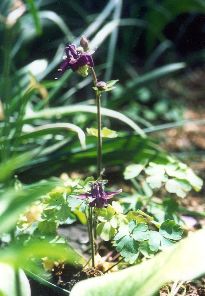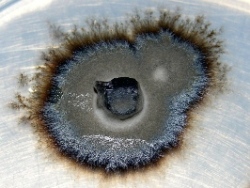Adaptation
Physiology
 The Aquilegia Vulgaris is a flowering plant that grows
to about 1 m ( 3 ft 3 in) tall. The plant has thin stems
that branch off. The plant is considered herbaceous perennial so
the plant lasts for more than two years. Gardeners do not have
to replant this in their gardens because it will grow back once
winter has passed. The plant is found in Europe so the flower is
very hardy and can survive cold weather. Columbine can withstand
up too -25 degrees Celsius.
The Aquilegia Vulgaris is a flowering plant that grows
to about 1 m ( 3 ft 3 in) tall. The plant has thin stems
that branch off. The plant is considered herbaceous perennial so
the plant lasts for more than two years. Gardeners do not have
to replant this in their gardens because it will grow back once
winter has passed. The plant is found in Europe so the flower is
very hardy and can survive cold weather. Columbine can withstand
up too -25 degrees Celsius.
Seeds
Since Aquilegia Vulgaris is apart of the Angiosperms it
produces flowers and seeds. The seeds have developed into small
packages that are able to make life when conditions are
favorable. Once a seed is in a suitable environment the seed
begins to grow using the energy stored in the endosperm. The
Columbine produces an abundant amount of seeds and quickly
spreads. See more in the
Reproduction page
Leaves
 ©Orjen, Wikicommons
©Orjen, Wikicommons
The Aquilegia Vulgaris has specialized cells in the
leaves that
control gas exchange in the cell. The hole that
facilitates gas exchange for the leaf is called a stoma and the
stoma is surrounded by two guard cells. The guard cells open and
close the stomata to control water loss. At night for example
when the plant cannot
© PdPhoto, wikimediacommons perform photosynthesis the guard cells
close to prevent water loss overnight. The image to the left is
a picture of two stomata, the top is open for gas exchange and
the bottom is closed.
Toxins
Columbine is known to be toxic and contains chemicals that deter
animals from eating it. The chemicals have been known to cause
symptoms of poisoning. To find out more about the toxins go to
the interactions page.
Water and Nutrients
Since Columbine has a complex root system that absorbs water
from the environment it has over time developed a symbiotic
relationship with fungi to more effectively absorb nutrients. The organism that helps is apart of the Glomeromycota and forms
©kuripop, wikimedia commons
endomycorrhizae which helps obtain nutrients. Specifically the
fungi grows into the plant cells and forms arbuscules which are
heavily branched and increase surface area for absorption. The
fungi exchanges important nutrients such as nitrogen and
phosphorus in exchange for glucose that the plant produces
through p hotosynthesis.
hotosynthesis.
©David Midgley, Wikimedia commons
To learn more about nutrition
click here
_02.jpg)